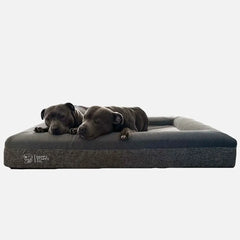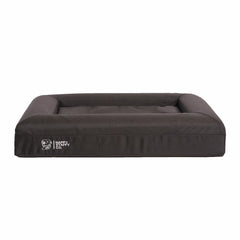Dogs have a way of turning everyday activities into charming, sometimes puzzling behaviours. Among these is the endearing (and occasionally chaotic) act of shaking their toys. While this behaviour might seem like a playful quirk, it’s deeply rooted in their instincts and personality. Dogs shake their toys as a natural expression of their prey drive, mimicking the instinct to catch and kill. Understanding why dogs shake their toys not only satisfies curiosity but also strengthens the bond between pets and their owners, offering insight into their emotional and physical needs.

Key Takeaways
-
Toy-shaking behaviour in dogs stems from ancestral hunting instincts, mimicking how wild canines would subdue prey.
-
Many dogs shake toys as a way to release pent-up energy and stay mentally and physically stimulated during playtime.
-
Carrying and shaking toys can signal comfort or attention-seeking behaviour, especially in dogs with strong emotional attachments.
-
Destructive shaking often reflects boredom, stress, or a natural need to chew, especially if the dog is left unstimulated.
-
Choosing the right type of toy encourages healthy shaking habits, with squeaky, plush, or durable options helping to meet their instinctual needs.
1. The Natural Instincts Behind the Shake
Predatory Origins
The behaviour of shaking toys harks back to a dog’s ancestral hunting instincts. Wolves, the wild ancestors of modern dogs, use rapid shaking to subdue or kill prey. This motion is a survival mechanism, ensuring their meal is immobilised quickly and efficiently. For domesticated dogs, this instinct persists, even in play. While your pup may never need to hunt for survival, the movement of shaking a toy mimics how a predator would handle small prey.
Reinforced by Play
Playtime serves as an outlet for these inherited behaviors. Certain breeds, like terriers and retrievers, exhibit stronger prey drives and are naturally inclined to shake their toys with gusto. This behaviour isn’t just instinctual—it’s fun and fulfilling for dogs, allowing them to mimic the actions of their wild counterparts. The movement triggers a satisfying response, often releasing bursts of energy and excitement.
2. Why Does My Dog Carry His Toy Everywhere?
Comfort and Security
To many dogs, toys are more than just objects—they’re sources of comfort. Much like a child’s favourite blanket or stuffed animal, a cherished toy can soothe anxiety and provide a sense of safety. Dogs may carry their toys from room to room, ensuring their comfort companion is always nearby. This behavior is especially common in puppies or dogs that have experienced past trauma, as toys can serve as security blankets.
Possessive or Territorial Behavior
Some dogs treat their toys as prized possessions. They may carry their “treasures” around as a way of protecting them or asserting ownership, especially in multi-dog households. If your dog hoards toys or growls when another pet approaches their favourite one, this may be a sign of possessiveness, which can be managed with training and reinforcement.
Attention-Seeking
Dogs are highly social creatures. Carrying a toy to their owner is often an invitation to engage, whether through play or affection. It’s their way of saying, “Let’s spend time together!” If your dog frequently brings you a toy and drops it at your feet, they likely crave interaction and stimulation.
3. Play Behavior and Toy Preferences
Mental and Physical Stimulation
Shaking toys isn’t just instinctive—it’s also mentally and physically stimulating. This activity helps dogs expend energy, stay engaged, and even develop problem-solving skills. The unpredictability of shaking a toy can create an entertaining and satisfying experience, preventing boredom and reducing stress.
Toy Types That Encourage Shaking
Certain toys are especially appealing to dogs who love to shake.
Squeaky toys mimic the sound of prey, triggering a dog’s hunting instincts.
Plush toys offer satisfying textures for gripping and shaking.
Rope toys encourage tugging and shaking, which can be beneficial for their teeth and gums.
Durable rubber toys provide a sturdy alternative for aggressive shakers, ensuring they don’t tear apart and ingest pieces.
4. Why Does My Dog Like to Destroy Toys?
Natural Chewing Instincts
Dogs have an innate need to chew and shred, a behavior tied to their hunting past. Destroying toys mimics the act of tearing apart prey, fulfilling a primal urge. Chewing also helps relieve teething discomfort in puppies and keeps adult dogs’ teeth clean and strong.
Stress or Boredom
For some dogs, destructive play is a way to cope with stress or alleviate boredom. Without adequate stimulation, they may channel pent-up energy into ripping their toys apart. Dogs left alone for long hours without enrichment may resort to destructive behaviours to self-soothe.
Reward-Seeking Behavior
Destroying toys, particularly squeaky ones, gives dogs a sense of accomplishment. The sound and sensation can be immensely satisfying, encouraging them to repeat the behaviour. If your dog tends to shred toys, consider tougher options designed for aggressive chewers.
Toy Durability Matters
Providing sturdy, chew-proof toys helps manage destructive tendencies, ensuring dogs can play safely without ingesting harmful materials. Look for high-quality materials that are non-toxic and designed to withstand heavy use.
5. Emotional Reasons for Shaking Toys
Stress Relief
Shaking toys is often a way for dogs to release anxiety or excess energy. However, it’s important to recognise when shaking is playful versus stress-induced. If your dog shakes toys excessively or aggressively, it may be a sign they need more exercise, stimulation, or emotional support.
Excitement and Joy
Toy shaking is frequently an expression of happiness. Whether it’s anticipating a game of fetch or simply revelling in the moment, this behaviour often signals a dog’s excitement. If your dog wags their tail, bounces around, or initiates play while shaking their toy, they’re likely enjoying themselves.
6. Social Behavior and Communication
How Dogs Use Toys to Interact
Toys play a vital role in canine communication. Shaking a toy in front of a human or another dog is often an invitation to join the fun. Dogs use play as a social bonding tool, reinforcing trust and companionship with their owners and fellow pets.
Displaying Dominance or Possessiveness
In some cases, shaking toys may reflect dominance or territorial behaviour. Dogs might use this action to assert their position in a social hierarchy, especially when interacting with other dogs. If a dog becomes overly possessive of a toy, resource-guarding training techniques may be necessary.
Is It Normal for Dogs to Shake Their Toys?

When Shaking Toys Might Indicate a Problem
While toy shaking is usually harmless, excessive aggression or overly intense shaking can signal underlying issues, such as frustration or overstimulation. If your dog’s play becomes destructive, obsessive, or accompanied by aggressive behaviours, it may be worth consulting a veterinarian or trainer.
How to Differentiate Healthy Play from Concerning Behavior
Monitor your dog’s frequency and intensity of toy shaking. Healthy play is usually accompanied by relaxed body language while concerning behaviour may involve signs of stress or aggression. If your dog growls excessively or becomes possessive over toys, intervention may be necessary.
Encouraging Positive Play Behavior
Choosing the Right Toys
Opt for safe, durable toys made from non-toxic materials. Toys designed for chewing or shaking should withstand regular use without breaking apart. Consider rotating toys to keep playtime engaging and prevent boredom.
Supervised Playtime
Keep an eye on your dog during play to prevent accidents, such as choking on small pieces of toys. If a toy becomes damaged, replace it promptly to avoid ingestion hazards.
Training and Redirection
If toy shaking becomes overly aggressive or inappropriate, use training techniques to redirect the behaviour. Positive reinforcement can help encourage healthier play habits, such as rewarding gentle play with praise and treats.
Strengthening Your Bond Through Fun Play
Using Toy-Shaking to Build Trust and Connection
Engaging with your dog during toy-shaking sessions fosters trust and strengthens your relationship. Play is a crucial aspect of a dog’s emotional well-being and helps reinforce their bond with their owners.
Interactive Play Ideas
Games like tug-of-war, fetch, and hide-and-seek are great ways to channel your dog’s energy and instincts while having fun together.
The act of shaking toys is a fascinating blend of instinct, emotion, and playfulness. From their ancestral hunting behaviours to their need for mental stimulation and stress relief, this behaviour reflects the many layers of a dog’s personality. By understanding and encouraging healthy play habits, pet owners can deepen their bond with their furry companions and celebrate the joyful, instinctual nature of dogs.




